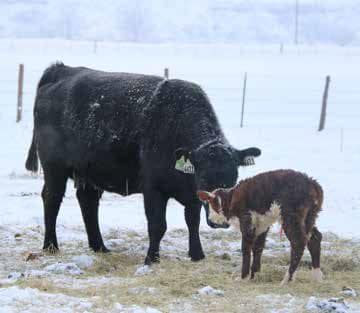
 A calf is a future herd replacement, breeding candidate or destined as protein on a consumer’s dinner plate. No matter if they are dairy, beef or a cross of the two, a healthy start sets them up for a lifetime of success. The key to giving them a healthy start is the feeding of clean, high quality colostrum, which is the ideal method of transferring proper nutrients and antibodies into newborn calves. The antibodies a calf receives from its mother help ward off disease until its own “naïve” immune system matures and effectively develops its own immune response.
A calf is a future herd replacement, breeding candidate or destined as protein on a consumer’s dinner plate. No matter if they are dairy, beef or a cross of the two, a healthy start sets them up for a lifetime of success. The key to giving them a healthy start is the feeding of clean, high quality colostrum, which is the ideal method of transferring proper nutrients and antibodies into newborn calves. The antibodies a calf receives from its mother help ward off disease until its own “naïve” immune system matures and effectively develops its own immune response.
When mother’s colostrum isn’t an option, a colostrum replacer (CR) can be entirely administered to newborns as a healthy alternative; and a colostrum supplement (CS) can be used to boost maternal colostrum.
Here are some tips to make the best decision for feeding colostrum to your newborn calves.
- Determine if you need a colostrum replacer or a colostrum supplement. (Also see for quick reference, Table 1, Beef Protocol, within this article.)Colostrum replacer. A product that is able to raise serum IgG concentration greater than 10 mg/ml within 24–48 hours after birth, in order to avoid failure of passive transfer (FPT), may be called a colostrum replacer.One dose of at least 115g IgG–immunity-transferring proteins commonly called immunoglobulins (IgGs)—is generally accepted to be the minimum required to meet this target, while providing sufficient immunity for disease protection for the calf. Newer industry standards suggest 150–200g for achieving higher successful passive transfer rates. Most replacement products contain at least 115g of Bovine IgG. You can always feed multiple bags of a supplement to reach that same level of IgG. Follow the instructions on the colostrum bag to understand how many bags to feed to replace maternal colostrum.Colostrum supplement. In general, products that contain less than 115g IgG per dose are categorized as colostrum supplements. These products are usually in the range of 50–60g IgG per package and, in a single dose, do not provide the calf with sufficient levels of immunity for disease protection. Supplements cannot replace high-quality colostrum, but they can be used to increase the amount of IgG fed to calves when maternal colostrum is partially inadequate either by quantity or quality. Partial contents of a replacement product can be also used as a supplement.
-
- How much colostrum is enough? The amount of colostrum needed depends on the quality of colostrum, size of the calf and timing and method of feeding. As a rule, calves should be fed an amount of colostrum equal to 10 percent of their body weight. To reduce calf losses and prepare calves to reach optimum long-term potential, most veterinarians now recommend that calves receive at least 1 gallon or 4 liters of good quality colostrum within the first 6 hours of life. This should provide calves with 150-200g of IgG. Research trials show that calves with higher serum IgG levels have higher long-term productivity, including weight gain and milk production as adults.
- When should colostrum be fed? The first feeding of colostrum should occur within one hour of birth. Within six hours, a calf’s gut closure reduces absorption of large IgG antibody proteins by as much as one-third. FPT for any reason, including the use of poor-quality colostrum, an insufficient quantity fed, or receiving colostrum too late and gut closure begins (in which openings in a calf’s gut lining shrink and become too small for large proteins such as IgGs to pass) can leave a calf vulnerable to disease and can even compromise its development and future performance.
-
- When choosing products, read and compare labels for IgG content and product effectiveness.
-
- Colostrum replacers vary in their makeup. Some are derived from bovine colostrum, while others from blood serum or a combination of the two. Products listed as real colostrum contain colostrum collected from dairy cattle that has been dried and heat-treated or irradiated to inactivate harmful agents such as those that cause Johne’s disease and mycoplasmosis. Serum products are essentially built from the ground up and use collected blood as the source of antibodies for the calf.
-
- Determine if the product is labeled with a claim for Bovine IgG or globulin proteins. IgG, more specifically IgG1, are the actual antibodies that protect the young calf from pathogens that may cause scours and respiratory diseases. Globulin proteins are comprised of a variety of other proteins as well as the IgG antibodies. To determine what percentage of the globulin protein is IgG, read the label to see what specific IgG level the package is guaranteed to contain.As discussed above, one dose of at least 115g IgG is generally accepted to be the minimum required in order to avoid failure of passive transfer (FPT), while providing sufficient immunity for disease protection for the calf. Feeding more colostrum is strongly recommended when calves are stressed, sanitation is poor or calfhood disease is high.
- Determine if the product is licensed by the USDA as a total replacement for maternal colostrum. A colostrum product that is licensed by the USDA guarantees the product’s potency or effectiveness in transferring immunity to calves within the first 12 hours of life. Licensed colostrum replacement products are classified as biologicals and are regulated by federal government agencies—in the U.S. by the USDA Center for Veterinary Biologics and in Canada by the Canadian Food and Inspection Agency.
-
 Don’t forget about colostral fat. A newborn calf requires colostral immunity along with an adequate source of natural colostral fat, hormones, growth factors, vitamins and minerals. The function of colostrum is to transfer all of these components from dam to calf.Colostral fat is a powerful nutrient that stimulates brown fat metabolism, which acts as an important source of energy required by the calf immediately after birth. For calves born into cold conditions and calves that have had a difficult or prolonged birth, this is especially important for regulating body temperature.Newborn calves have a narrow thermal-neutral zone—59°–77°F (15–25°C). Either colder or warmer, a calf needs additional energy to maintain metabolism. Therefore, the administration of high-quality colostrum containing natural colostral fat as soon as possible after birth helps calves defend themselves against cold stress.The USDA estimates that 95,000 calves die each year due to cold stress. The majority of young calf deaths occur within 24 hours after birth and often because calves fail to receive the energy they need to survive. Newborn calves have a narrow thermal-neutral zone—59°–77°F (15–25°C). Either colder or warmer, a calf needs additional energy to maintain metabolism. Therefore, the administration of high-quality colostrum containing natural colostral fat as soon as possible after birth helps calves defend themselves against cold stress.When determining colostral quality, consider both immunoglobulin as well as natural fat concentrations. A good rule is to look for at least 14% colostral fat on the label. A label is your best bet for checking the ingredients and nutritional analysis of colostrum products, and so is the advice of your veterinarian.
Don’t forget about colostral fat. A newborn calf requires colostral immunity along with an adequate source of natural colostral fat, hormones, growth factors, vitamins and minerals. The function of colostrum is to transfer all of these components from dam to calf.Colostral fat is a powerful nutrient that stimulates brown fat metabolism, which acts as an important source of energy required by the calf immediately after birth. For calves born into cold conditions and calves that have had a difficult or prolonged birth, this is especially important for regulating body temperature.Newborn calves have a narrow thermal-neutral zone—59°–77°F (15–25°C). Either colder or warmer, a calf needs additional energy to maintain metabolism. Therefore, the administration of high-quality colostrum containing natural colostral fat as soon as possible after birth helps calves defend themselves against cold stress.The USDA estimates that 95,000 calves die each year due to cold stress. The majority of young calf deaths occur within 24 hours after birth and often because calves fail to receive the energy they need to survive. Newborn calves have a narrow thermal-neutral zone—59°–77°F (15–25°C). Either colder or warmer, a calf needs additional energy to maintain metabolism. Therefore, the administration of high-quality colostrum containing natural colostral fat as soon as possible after birth helps calves defend themselves against cold stress.When determining colostral quality, consider both immunoglobulin as well as natural fat concentrations. A good rule is to look for at least 14% colostral fat on the label. A label is your best bet for checking the ingredients and nutritional analysis of colostrum products, and so is the advice of your veterinarian.- Have a plan in place. Late night calvings and cold winter storms are situations that require special attention toward newborn calves. Whatever protocol is best for your ranch, be sure to have a proper plan in place for all members and employees to abide by. Always have colostrum replacers and supplements on hand because you never know when a calf might need one.

Republished with permission from MWI Animal Health. Source: Producer Outlook, Winter 2021




























